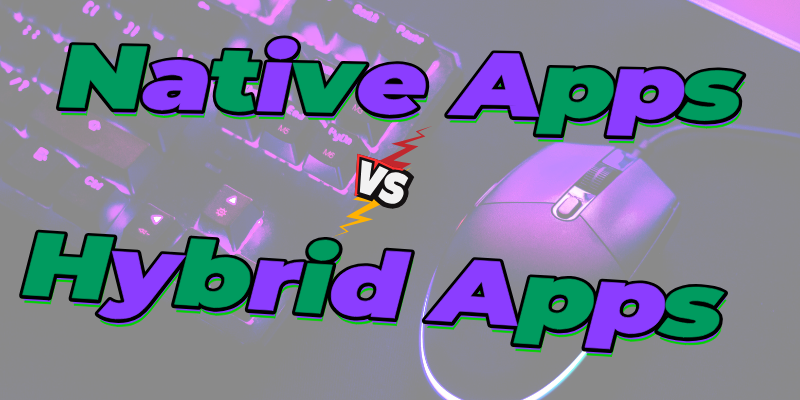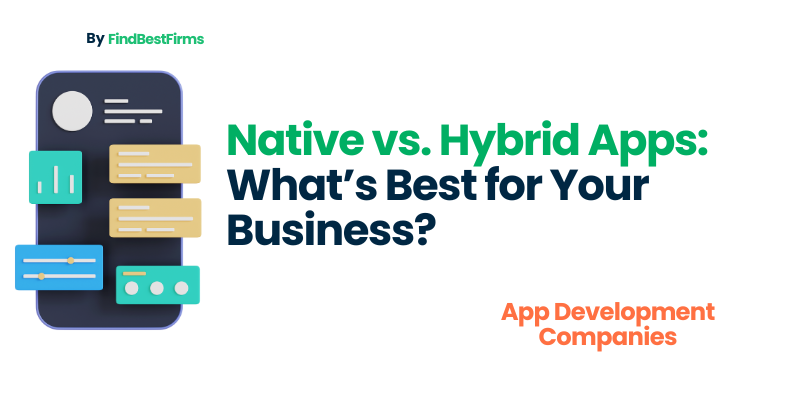Now that everything is online, it’s vital for businesses to be available on mobile devices. Everyone from a company’s top executive to a product manager may ask themselves: What should we do, go for a native or a hybrid approach?
Deciding on the right kind of mobile app matters a lot for your success. There are unique upsides, downsides and effects on the future for each type of application. Throughout this blog, we’ll explain both options, compare them side by side and assist you in picking what your business needs.

What Are Native Apps?
Native apps are mobile applications developed specifically for one platform—iOS or Android. They’re built using platform-specific languages such as Swift or Objective-C for iOS and Kotlin or Java for Android. Because they’re tailored to the operating system’s framework, native apps offer an optimized experience in performance, interface design, and feature access.
For example, Instagram and Spotify are native apps that operate seamlessly on their respective platforms, offering fast performance and robust user experiences.
What Are Hybrid Apps?
Hybrid apps, on the other hand, are built using web technologies like HTML, CSS, and JavaScript and wrapped in a native shell using frameworks like React Native, Flutter, or Ionic. This allows developers to write the code once and deploy it across multiple platforms (iOS and Android).
Think of hybrid apps as websites running inside a native app container. They can access some device features using plugins and APIs, although not as extensively or efficiently as native apps.
Popular hybrid apps include X Corp. and Evernote, which use cross-platform frameworks to ensure consistent experiences across devices without the cost of building two separate apps.
Key Differences Between Native and Hybrid Apps
Let’s break down the key differentiators that matter most when making your decision:
Platform Compatibility
Native: Built for one platform (iOS or Android) at a time.
Hybrid: Built once and deployed on both platforms.
Performance and Speed
Native: Offers high performance and responsiveness due to platform-optimized code.
Hybrid: Slightly slower, especially for heavy animations or intensive processing.
User Experience (UX/UI)
Native: Delivers a superior and tailored user experience.
Hybrid: May feel less smooth due to limited native elements.
Development Cost and Time
Native: More expensive and time-consuming since you’re developing two separate apps.
Hybrid: More cost-effective and faster with a single codebase.
Access to Device Features
Native: Full access to all device APIs, sensors, camera, GPS, etc.
Hybrid: Limited or dependent on third-party plugins.
Maintenance and Updates
Native: Requires updates for each platform individually.
Hybrid: Single update covers both platforms, simplifying maintenance.
Native V/S Hybrid Apps
| Aspect | Native Apps | Hybrid Apps |
| Platform Compatibility | Built specifically for one platform (iOS or Android) | One codebase runs on both iOS and Android |
| Performance | High performance; optimized for platform | Slightly lower performance; may lag with complex tasks |
| User Experience (UX/UI) | Superior UX/UI; follows platform-specific guidelines | Decent UX/UI; may not fully match native look and feel |
| Development Time | Longer; separate codebases for each platform | Faster; shared codebase reduces time |
| Development Cost | Higher; needs two separate teams or more work | Lower; single team and one codebase |
| Access to Device Features | Full access to all native APIs and hardware components | Limited access; relies on third-party plugins |
| App Store Performance | Better support and visibility in app stores | May face restrictions or issues with store compliance |
| Maintenance & Updates | Requires separate updates for each platform | One update applies to all platforms |
| Offline Functionality | Robust offline support | Available but may be less reliable |
| Use Case Suitability | Ideal for high-performance or feature-rich apps | Great for MVPs, simple apps, or budget-conscious projects |
Pros and Cons of Native Apps
Pros
Top-tier Performance: Native apps run faster and smoother, ideal for graphics-heavy or real-time applications.
Superior UX/UI: Seamless integration with platform-specific UI components enhances the user experience.
Full Hardware Access: Direct access to device capabilities like Bluetooth, camera, and sensors.
Better App Store Support: Higher acceptance rate and visibility in app stores.
Cons
Higher Cost: You’ll need separate development teams or processes for iOS and Android.
Longer Time to Market: Building and testing separate apps takes more time.
Duplicate Efforts: Any changes need to be implemented in both versions.
Pros and Cons of Hybrid Apps
Pros
Cost-Efficient: One codebase reduces development and maintenance expenses.
Faster Development: A quicker route to market with simultaneous platform deployment.
Easy Maintenance: Fix bugs or roll out updates once across all platforms.
Good Enough UX/UI: For many businesses, hybrid performance is more than adequate.
Cons
Performance Limitations: Hybrid apps may lag in performance compared to native apps.
UI Constraints: Might not fully align with platform-specific design guidelines.
Limited Access to Device Features: Relies on plugins, which can sometimes be outdated or buggy.
Troubleshooting Challenges: Bugs specific to one platform can be harder to isolate and fix.
Use Cases: When to Choose Native Apps
Opt for native app development if your business falls into one of these categories:
1. You’re Building a High-Performance App
Games, 3D visuals, and AR/VR apps demand the speed and precision of native code.
2. User Experience is a Top Priority
If your app’s success depends on smooth animations, fast load times, and intuitive navigation, go native.
3. You Need Access to Device Hardware
Apps that rely on advanced device features like biometric authentication, camera functions, or offline GPS tracking are better suited to native development.
4. Long-Term Investment
Native apps are ideal if you’re planning for scalability and long-term growth with consistent feature enhancements.
Use Cases: When to Choose Hybrid Apps
Hybrid apps are ideal in the following situations:
1. MVP or Startup Launch
If you’re testing the market with a minimum viable product (MVP), hybrid is the faster, cheaper route.
2. Budget is a Constraint
Hybrid apps help small businesses save on development costs without sacrificing usability.
3. Simple Utility Apps
For apps like calculators, booking forms, or directories, hybrid solutions work perfectly.
4. Cross-Platform Audience
If your audience spans both iOS and Android, a hybrid approach allows you to cater to everyone efficiently.
Business Factors to Consider Before Deciding
When making your final decision, keep these strategic points in mind:
1. Budget
A tight budget leans in favor of hybrid development. Native is a higher upfront investment but may pay off in long-term performance and satisfaction.
2. Time-to-Market
If you’re racing a deadline or want to capitalize on a trending opportunity, hybrid gets you there faster.
3. Target Audience
Does your audience predominantly use one platform? If so, native might be the smarter focus.
4. App Complexity
For complex workflows, animations, or high-performance needs, native is better. Simple apps? Go hybrid.
5. Long-Term Goals
Think beyond launch. Consider how easy it’ll be to scale, maintain, and evolve the app over time.
Expert Opinion: What Industry Leaders Say
Mobile app development experts often suggest a hybrid approach for startups and MVPs, and native for apps that demand high performance or are central to the business model.
John Saddington, a mobile app strategist, says,
“If your app is your business, go native. But if your app supports your business, hybrid can work beautifully.”
A recent survey by Statista also found that 67% of developers prefer hybrid frameworks for rapid prototyping, while 55% choose native for scalability and performance.
The key takeaway? It’s not about which is better in general—it’s about what’s better for your business model, timeline, and customer expectations.
Final Thoughts
When choosing between native and hybrid app development, there’s no universal right answer. The best choice depends on your business goals, budget, performance expectations, and long-term vision.
If you need a polished, high-performance app that leverages the full power of the device, investing in a native app is the way to go. But if you’re looking to launch quickly and economically without compromising on essential functionality, hybrid apps are a smart alternative.
Remember, your app is a digital extension of your brand. Whether you choose a native or hybrid approach, ensure your app provides value, solves a problem, and creates a great user experience.
And if you’re not sure where to start, consider working with a professional web designer or app development partner who can guide you through the decision-making process—so you don’t just build an app, you build the right app.

